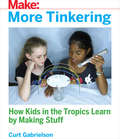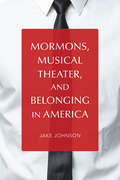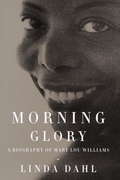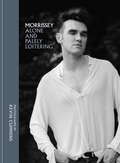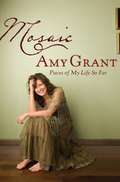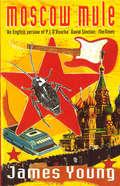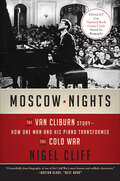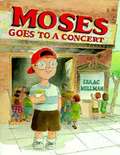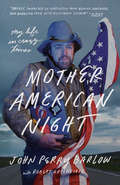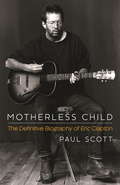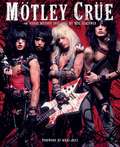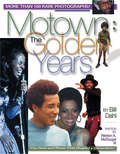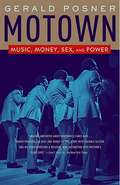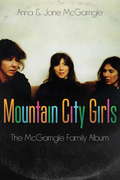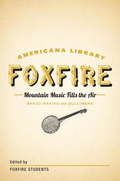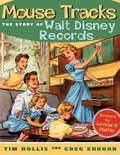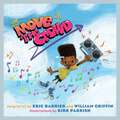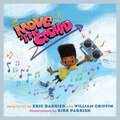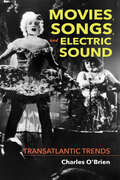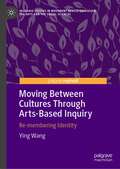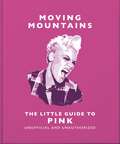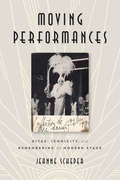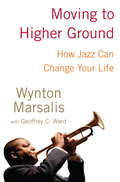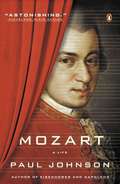- Table View
- List View
More Tinkering: How Kids in the Tropics Learn by Making Stuff
by Curt GabrielsonTinkering is a way of learning through hands-on activity -- experimenting with materials and devices to see how they work, taking things apart, making small changes and improvements, exploring and inventing. Tinkering may seem like a form of play -- and it is -- but it is also a powerful way of discovering truths about science, engineering, and math. With this book, Curt Gabrielson follows up on his best-seller Tinkering: Kids Learn by Making Stuff with this all-new volume that features more than three dozen fun and educational tinkering projects based on his years of working with kids in the tropical island nation of Timor-Leste. Step-by-step instructions accompanied by full-color photos take you through a range of enjoyable projects that explore life sciences, physics, chemistry, earth sciences, and mathematics. You'll discover how math is used to make baskets, how fungi create fermentation, how electricity can make a magnet, how the greenhouse effect creates warming, and much more. The author also enlivens his latest batch of tinkering projects with colorful tales of his experiences in the tropic and the lives of the people he' s met there.Inside you'll find:Clear directions for making simple projects and doing activities that teach science, mathematics and engineeringProjects rooted in day to day life and experience in a small, developing nation in the Asian tropicsFull-color photographs throughoutExplicit connections to standard STEAM concepts, K-12Activities doable with less than $5 worth of common materialsThis book is perfect for parents, teachers, and students with an interest in hands-on, tinkering-based science and mathematics education, whether in traditional schools or in home-schooling situations. It will also be of interest to anyone who wants to learn more about developing nations, the culture and unique history of Timor-Leste, tropical nations or Asian cultures, with specific links to Indonesia, Portugal, or Australia.
Mormons, Musical Theater, and Belonging in America (Music in American Life)
by Jake JohnsonThe Church of Jesus Christ of Latter-day Saints adopted the vocal and theatrical traditions of American musical theater as important theological tenets. As Church membership grew, leaders saw how the genre could help define the faith and wove musical theater into many aspects of Mormon life. Jake Johnson merges the study of belonging in America with scholarship on voice and popular music to explore the surprising yet profound link between two quintessentially American institutions. Throughout the twentieth and twenty-first centuries, Mormons gravitated toward musicals as a common platform for transmitting political and theological ideas. Johnson sees Mormons using musical theater as a medium for theology of voice--a religious practice that suggests how vicariously voicing another person can bring one closer to godliness. This sounding, Johnson suggests, created new opportunities for living. Voice and the musical theater tradition provided a site for Mormons to negotiate their way into middle-class respectability. At the same time, musical theater became a unique expressive tool of Mormon culture.
Morning Glory
by Linda DahlMary Lou Williams -- pianist, arranger, composer, and probably the most influential woman in the history of jazz -- receives the attention she has long deserved in the definitive biography by a leading scholar of women in jazz.The illegitimate child of an impoverished and indifferent mother, Williams began performing publicly at the age of seven when she became known admiringly in her native Pittsburgh as "the little piano girl of East Liberty," playing one day for the Mellons at bridge teas and the next in gambling dens where the hat was passed for change. She grew up with the jazz of the early part of the century, championed by the likes of Earl Hines and Fats Waller, yet unlike so many other musicians of her time, she was open to new forms in jazz -- she was an early champion of bop, and a mentor and colleague to its central figures, such as Thelonius Monk and Bud Powell -- and in broader musical styles as well (after her conversion to Catholicism, she wrote masses and other sacred music).Most of the other famous women in jazz -- Billie Holiday, Ella Fitzgerald -- have been singers. Williams was instead a phenomenal pianist who performed solo, with small groups and big bands, in vaudeville and clubs, and on numerous records. But she is equally well known today as a composer and arranger of remarkable versatility and power, having worked with, among others, Duke Ellington and Benny Goodman. Her compositions have been recorded by artisits as varied as Marian McPartland, Dizzy Gillespie, Nat "King" Cole, Sarah Vaughan, Ella Fitzgerald, and herself -- and, more recently, by cutting-edge players Geri Allen and Dave Douglas.But Williams was more than "just a musician"; her interests were catholic in both senses, and she struggled to combine her love of music with her love of God. She was a tireless humanitarian, and made ongoing attempts to help dozens of down-and-out musicians; in the 1950s, her apartment was, at times, virtually a rehab. Though she was often in emotional despair, she found comfort for her many disappointments and hurts not only in her music but in her spirituality.Linda Dahl, granted unprecedented access to the large Williams archive, has given us the whole of Williams's very full life, from her often harrowing days on the road to her tumultuous marriages and love affairs, from the ups and downs of her unique fifty-year career to the remarkable spirituality that came to inform both her daily life and her music. This is a striking protrait of one of our least understood and most important musicians.
Morrissey: Alone and Palely Loitering
by Kevin Cummins'One of the greatest music photographers of all time...this book is indispensable to anyone who is a fan of Morrissey, or of great photography 'Classic Pop magazine'Unsurprisingly, given Cummin's history, the photographs are beautifully composed, from the live shots with their webbing of shredded shirts and outstretched arms to the lyrical portraits on staircases or Japanese streets'Q MagazineTaken by renowned photographer Kevin Cummins and featuring hundreds of previously unseen images, Alone and Palely Loitering chronicles Morrissey's world as he emerged from The Smiths and established himself as a solo artist.Breathtaking photographs cover chaotic live performances, intimate portrait sessions and snatched moments backstage and on tour over a ten-year period. Cummins provides insightful commentary on the art of photography and what it was like to work and travel with Morrissey.The book also includes portraits of from fans around the world with Morrissey-inspired tattoos, featuring an essay by literary academic Dr Gail Crowther exploring how this art form is used to display devotion to a unique musician.
Mosaic: Pieces of My Life So Far
by Amy GrantOne of America’s most popular music artists shares beautiful pieces of an unforgettable human mosaic, revealing pieces of a life in progress. With her unmistakable voice and honest lyrics, Amy Grant has captured a unique place in American music. As the bestselling Christian music artist of all time, a crossover pop sensation, and the wife of country music star Vince Gill, Amy has lived much of her life in the spotlight, subject to adulation, speculation, and scrutiny. Now for the first time she bare...
Moscow Mule
by James YoungA marvellously funny and sharply observed account of a journey to Russia by one of Britain's most talented young writers. Moscow - a labyrinth where the humans try to keep one step ahead of the roaches. Everyone on the move, some in search of the quick buck, and others just trying to survive. All dazzled by the neon glare of the western dream. The soviet monolith has broken down in tribalism, tribes who go to war not just on the streets but in overheated rooms, with drugs, vodka and Cindy Crawford carrier bags. James Young gives an unparalleled account of today's Moscow from the bottom side up. He takes us on a odyssey through this strange no man's land where East meets West, where the old certainties have gone, the KGB men wear Italian suits, the Mafia tycoonskis style themselves on the Godfather flicks and the rest are queuing to change dollars.
Moscow Nights: The Van Cliburn Story-How One Man and His Piano Transformed the Cold War
by Nigel Cliff“A rousing, well-researched biography” of the Texan piano prodigy who crossed the Iron Curtain at the height of the Cold War (Kirkus, starred review). A National Book Critic’s Circle FinalistIn 1958, an unheralded young pianist named Van Cliburn traveled to Moscow to compete in the First International Tchaikovsky Competition. The Soviets had no intention of bestowing their coveted prize on an unknown American; a Russian pianist had already been chosen to win. Yet when the gangly Texan with the shy grin began to play, he instantly captivated an entire nation.The Soviet people were charmed by Van Cliburn’s extraordinary talent, but it was his palpable love for the music that earned their devotion; for many, he played more like a Russian than their own musicians. As enraptured crowds mobbed Cliburn’s performances, pressure mounted to award him the competition prize. “Is he the best?” Soviet Premier Nikita Khrushchev demanded of the judges. “In that case . . . give him the prize!”Adored by millions in the USSR, Cliburn returned to a hero’s welcome in the USA and became, for a time, an ambassador of hope. In this thrilling, impeccably researched account, Nigel Cliff recreates the drama and tension of the Cold War era, and brings into focus the gifted musician whose music would temporarily bridge the divide between two dangerously hostile powers.
Moses Goes to a Concert
by Isaac Millman"Moses and his school friends are deaf, but like most children, they have a lot to say. They communicate in American Sign Language, using visual signs and facial expressions. This is called signing. And even though they can't hear, they can enjoy many activities through their other senses. Today, Moses and his classmates are going to a concert. Their teacher, Mr. Samuels, has two surprises in store for them, to make this particular concert a special event."
Mother American Night: My Life in Crazy Times
by John Perry Barlow Robert GreenfieldJohn Perry Barlow’s wild ride with the Grateful Dead was just part of a Zelig-like life that took him from a childhood as ranching royalty in Wyoming to membership in the Internet Hall of Fame as a digital free speech advocate.Mother American Night is the wild, funny, heartbreaking, and often unbelievable (yet completely true) story of an American icon. Born into a powerful Wyoming political family, John Perry Barlow wrote the lyrics for thirty Grateful Dead songs while also running his family’s cattle ranch. He hung out in Andy Warhol’s Factory, went on a date with the Dalai Lama’s sister, and accidentally shot Bob Weir in the face on the eve of his own wedding. As a favor to Jacqueline Kennedy Onassis, Barlow mentored a young JFK Jr. and the two then became lifelong friends. Despite being a freely self-confessed acidhead, he served as Dick Cheney’s campaign manager during Cheney’s first run for Congress. And after befriending a legendary early group of computer hackers known as the Legion of Doom, Barlow became a renowned internet guru who then cofounded the groundbreaking Electronic Frontier Foundation.His résumé only hints of the richness of a life lived on the edge. Blessed with an incredible sense of humor and a unique voice, Barlow was a born storyteller in the tradition of Mark Twain and Will Rogers. Through intimate portraits of friends and acquaintances from Bob Weir and Jerry Garcia to Timothy Leary and Steve Jobs, Mother American Night traces the generational passage by which the counterculture became the culture, and it shows why learning to accept love may be the hardest thing we ever ask of ourselves.
Motherless Child: The Definitive Biography of Eric Clapton
by Paul ScottFrom the Yardbirds to Cream, Blind Faith to Derek and the Dominos, and a hugely-successful solo career, Eric Clapton's fifty years in the music business can look like an uninterrupted rise to become one of the greatest guitar players who ever lived. But his story is as complicated as it is fascinating.Clapton's god-like skill with a guitar was matched by an almost equal talent for self-destruction. He has never shied away from telling the truth about his battles with drink and drugs - or the sometimes catastrophic impact they had on the other people in his life, including his first wife Pattie Boyd. And without those deep personal lows we may never have had the musical highs that won him millions of fans. His story is also one of a long but successful road to sobriety, redemption and happiness.Motherless Child chronicles Clapton's remarkable journey: the music, the women, the drugs, the cars, the guitars, the heartbreak and the triumphs are all here. The book includes interviews with some people close to Clapton who have never spoken on the record before. It explores his musical legacy as one of the most influential musicians of his generation, and as the keeper of the flame for the blues.
Motley Crue
by Nikki Sixx Neil ZlozowerMötley Crüe's gleeful glam debauchery and unstoppable anthems have made them metal gods, selling over 72 million album copies worldwide and landing their band biography The Dirt on bestseller lists around the country. Mötley Crüe is--amazingly--the first photographic history of the band. Legendary rock photographer Neil Zlozower's images capture the band's rise from their breakthrough album Shout at the Devil through rock 'n' roll excesses to follow with the unprecedented all-access candor of a friend to the band. In hundreds of photographs and stories from the band and those close to them, Mötley Crüe reveals them onstage, backstage, on tour, hanging out, and in studio--a must-have album of photos and testimony on one of the most powerful and controversial bands in rock history.
Motown: More than 100 rare photographs
by Bill DahlThis is the book for lovers of Motown! Author and Motown historian Bill Dahl has expertly compiled this comprehensive guide to the musical combination of pop and gospel, known as Motown.This new compilation features an A-to-Z listing and biography of nearly every Motown group since its beginning in 1959. Also included are never-before-published photos from former Motown promotions guru Weldon A. McDougal III. Enthusiasts will now have a chance to own a complete encyclopedia of groups and artists, along with information about their music, including a discography and price guide. • 32-page color section containing many never-before-published photos • Complete encyclopedia of groups, artists, plus discography and price guide for all Motown acts
Motown: Music, Money, Sex, and Power
by Gerald PosnerIn 1959, twenty-nine-year-old Berry Gordy, who had already given up on his dream to be a champion boxer, borrowed eight hundred dollars from his family and started a record company. A run-down bungalow sandwiched between a funeral home and a beauty shop in a poor Detroit neighborhood served as his headquarters. The building's entrance was adorned with a large sign that improbably boasted "Hitsville U. S. A. " The kitchen served as the control room, the garage became the two-track studio, the living room was reserved for bookkeeping, and sales were handled in the dining room. Soon word spread that any youngster with a streak of talent should visit the only record label that Detroit had seen in years. The company's name was Motown. Motown cuts through decades of unsubstantiated rumors and speculation to tell the true behind-the-scenes narrative of America's most exciting musical dynasty. It follows the company and its amazing roster of stars from the tumultuous growth years in Detroit, to the drama and intrigue of Hollywood in the 1970s, to resurgence in 2002. Set against the civil rights movement, the decay of America's northern industrial cities, and the social upheaval of the 1960s, Motown is a tale of the incredible entrepreneurship of Berry Gordy. But it also features the moving stories of kids from Detroit's inner-city projects who achieved remarkable success and then, in many cases, found themselves fighting the demons that so often come with stardom--drugs, jealousy, sexual indulgence, greed, and uncontrollable ambition. Motown features an extraordinary cast of characters, including Diana Ross, Michael Jackson, Marvin Gaye, Smokey Robinson, and Stevie Wonder. They are presented as they lived and worked: a clan of friends, lovers, competitors, and sometimes vicious foes. Motown reveals how the hopes and dreams of each affected the lives of the others and illustrates why this singular story is a made-in-America Greek tragedy, the rise and fall of a supremely talented yet completely dysfunctional extended family. Based on numerous original interviews and extensive documentation, Motown benefits particularly from the thousands of pages of files crammed into the basement of downtown Detroit's Wayne County Courthouse. Those court records provide the unofficial--and hitherto largely untold--history of Motown and its stars, since almost every relationship between departing singers, songwriters, producers, and the label ended up in litigation. From its peaks in the late 1960s and early 1970s, when Motown controlled the pop charts and its stars were sought after even by the Beatles, through the inexorable slide caused by their failure to handle their stardom, Motown is a riveting and troubling look inside a music label that provided the unofficial soundtrack to an entire generation. From the Hardcover edition.
Mountain City Girls
by Anna Mcgarrigle Jane McgarrigleThe first book and definitive family memoir from Anna and Jane McGarrigle, sisters to Kate McGarrigle and aunts of Rufus and Martha Wainwright. This book is truly a classic in the making. The McGarrigles are known around the world for their touching, insightful songs about love, loss and family. But where and how does a family so rich in musical luminaries take root? In Mountain City Girls, Anna and Jane recount their childhood in Montreal and the Laurentian Mountains, and go further back to their ancestors' early days in Canada, and their parents' courtship and marriage. A vivid snapshot of coming-of-age in the 1950s, the book recounts the sisters' school days and rebellious teenage antics, and their beginnings as musicians. It takes us through the vibrant folk music circuit of the 1960s in Montreal and New York City, and the burgeoning social movements of San Francisco, and ultimately leads to the formation of the folk music duo Kate and Anna McGarrigle, revealing the genesis behind some of their beloved songs and following their early days recording and performing. The book also reads as a tribute to Kate, who passed away in 2010, with insights into her character and creative development. Inspiringly, it speaks to the important (sometimes lifesaving) role of sisters, and is a deeply moving testament to the profound importance of family. Charming and witty, interspersed with lyrics and photos, this book captures the McGarrigles' lives, idiosyncratic upbringing, and literary and musical influences. No one can tell the story of the McGarrigles better than Anna and Jane, or in such an inimitable, intimate way.
Mountain Music Fills the Air: The Foxfire Americana Libray (11) (The Foxfire Americana Library)
by Inc. Foxfire FundBanjos and dulcimers have always been an essential part of Appalachian music, shared and enjoyed throughout the generations. Here, musicians share the history of the instruments and show how they are constructed, piece by piece, with photos and diagrams.
Mouse Tracks: The Story of Walt Disney Records
by Greg Ehrbar Tim HollisAround the world there are grandparents, parents, and children who can still sing ditties by Tigger or Baloo the Bear or the Seven Dwarves. This staying power and global reach is in large part a testimony to the pizzazz of performers, songwriters, and other creative artists who worked with Walt Disney Records. Mouse Tracks: The Story of Walt Disney Records chronicles for the first time the fifty-year history of the Disney recording companies launched by Walt Disney and Roy Disney in the mid-1950s, when Disneyland Park, Davy Crockett, and the Mickey Mouse Club were taking the world by storm. The book provides a perspective on all-time Disney favorites and features anecdotes, reminiscences, and biographies of the artists who brought Disney magic to audio. Authors Tim Hollis and Greg Ehrbar go behind the scenes at the Walt Disney Studios and discover that in the early days Walt Disney and Roy Disney resisted going into the record business before the success of "The Ballad of Davy Crockett" ignited the in-house label. Along the way, the book traces the recording adventures of such Disney favorites as Mickey Mouse, Donald Duck, Cinderella, Bambi, Jiminy Cricket, Winnie the Pooh, and even Walt Disney himself. Mouse Tracks reveals the struggles, major successes, and occasional misfires. Included are impressions and details of teen-pop princesses Annette Funicello and Hayley Mills, the Mary Poppins phenomenon, a Disney-style "British Invasion," and a low period when sagging sales forced Walt Disney to suggest closing the division down. Complementing each chapter are brief performer biographies, reproductions of album covers and art, and facsimiles of related promotional material. Mouse Tracks is a collector's bonanza of information on this little-analyzed side of the Disney empire. Learn more about the book and the authors at www.mousetracksonline.com.
Move the Crowd: A Children's Picture Book (LyricPop #0)
by Eric Barrier William GriffinInnovative illustrator Kirk Parrish brings the iconic song "Move the Crowd" to life for the first time as a children's picture book. With knowledge of self, there's nothing I can't solve At 360 degrees I revolve This is actual fact, i
Move the Crowd: A Children's Picture Book (LyricPop)
by Eric Barrier William GriffinInnovative illustrator Kirk Parrish brings the iconic song “Move the Crowd” to life for the first time as a children’s picture book. “'Move The Crowd' as a children’s picture book is truly as wondrous as it sounds.” —Exclusive Magazine "With knowledge of self, there’s nothing I can’t solve At 360 degrees I revolve This is actual fact, it’s not an act, it’s been proven Indeed and I proceed to make the crowd keep moving . . ." Innovative illustrator Kirk Parrish brings the iconic song “Move the Crowd” to life for the first time as a children’s picture book. The lyrics to Eric B. and Rakim’s hit song provide the inspiration for this instant classic. Follow along as Parrish pairs the lyrics with colorful illustrations about a boy being absorbed into his stereo and dropped into a colorless world where the music is dull and the people uninspired. The ensuing transformation he brings to the crowd with his music is one that the whole family can enjoy together.
Movies, Songs, and Electric Sound: Transatlantic Trends
by Charles O’BrienAn exploration of how the introduction of recorded music affected the production, viewing experience, and global export of movies.In Movies, Songs, and Electric Sound, Charles O’Brien examines American and European musical films created circa 1930, when the world’s sound-equipped theaters screened movies featuring recorded songs and filmmakers in the United States and Europe struggled to meet the artistic and technical challenges of sound production and distribution. The presence of singers in films exerted special pressures on film technique, lending a distinct look and sound to the films’ musical sequences. Rather than advancing a film’s plot, songs in these films were staged, filmed, and cut to facilitate the singer’s engagement with her or his public. Through an examination of the export market for sound films in the early 1930s, when German and American companies used musical films as a vehicle for competing to control the world film trade, this book delineates a new transnational context for understanding the Hollywood musical. Combining archival research with the cinemetric analysis of hundreds of American, German, French, and British films made between 1927 and 1934, O’Brien provides the historical context necessary for making sense of the aesthetic impact of changes in film technology from the past to the present.“Movies, Songs, and Electric Sound is an insightful study in the beginning of cinema’s sound era.” —popcultureshelf.com
Moving Between Cultures Through Arts-Based Inquiry: Re-membering Identity (Palgrave Studies in Movement across Education, the Arts and the Social Sciences)
by Ying WangThis book is an exploration of the concept of in-betweenness, as it occurs within the process of moving between the author’s root culture and adopted culture, from her perspective as an immigrant creative arts therapist. Through the critical autoethnographic voice and a/r/tographic inquiry, she introduces a unique exploration site within the process of Guqin-making, an ancient Chinese art form. Through the creation of images and poetry, and through Guqin-making and music-making/playing, the book expands the discussion of in-betweenness by re-theorising ancient Chinese philosophical perspectives on harmonic space. This contribution to arts-based research provides a unique standpoint to explore research methods of moving, walking, making, resting and awakening. It showcases how other researchers can transfer the invisible and intangible embodied feelings, memories and emotions arising from moving between two or more cultures into visible and tangible images, narrative, poetry, craft and music-playing to conduct powerful, interdisciplinary arts-based research.
Moving Mountains: America's Miss Understood Since 2001 (The\little Book Of... Ser.)
by Orange Hippo!"I'm proof that things absolutely can happen." - PinkDubbed the next "Queen of Pop" for her distinctive voice and live acrobatic stage performances, Pink unapologetically smashed her way through the music industry at the mere age of 14. The incredible success of her masterpiece Missundaztood showcased the reality of Pink to the world; a strong, rebellious yet vulnerable woman who was here to conquer the music industry. With over 135 million albums and singles sold worldwide, nine studio albums and a long list of accolades, she is one of the world's best-selling music artists.Moving Mountains: The Little Guide to Pink is bursting with quotes taken from the mouth of the "toothless tiger" herself across interviews from all eras of her continuing career. From relatable quips to fascinating facts from her wild teenage days, this tiny tome will get you ready to paint the world pink.
Moving Mountains: America's Miss Understood Since 2001 (The\little Book Of... Ser.)
by Orange Hippo!"I'm proof that things absolutely can happen." - PinkDubbed the next "Queen of Pop" for her distinctive voice and live acrobatic stage performances, Pink unapologetically smashed her way through the music industry at the mere age of 14. The incredible success of her masterpiece Missundaztood showcased the reality of Pink to the world; a strong, rebellious yet vulnerable woman who was here to conquer the music industry. With over 135 million albums and singles sold worldwide, nine studio albums and a long list of accolades, she is one of the world's best-selling music artists.Moving Mountains: The Little Guide to Pink is bursting with quotes taken from the mouth of the "toothless tiger" herself across interviews from all eras of her continuing career. From relatable quips to fascinating facts from her wild teenage days, this tiny tome will get you ready to paint the world pink.
Moving Performances: Divas, Iconicity, and Remembering the Modern Stage
by Jeanne ScheperFabulous yet fierce, imperious yet impetuous, boss yet bitchy—divas are figures of paradox. Their place in culture is equally contradictory, as they are simultaneously venerated and marginalized, hailed as timeless but then frequently forgotten or exhumed as cult icons by future generations. Focusing on four early twentieth-century divas—Aida Overton Walker, Loïe Fuller, Libby Holman, and Josephine Baker—who were icons in their own time, Moving Performances considers what their past and current reception reveals about changing ideas of race and gender. Jeanne Scheper examines how iconicity can actually work to the diva’s detriment, reducing her to a fetish object, a grotesque, or a figure of nostalgia. Yet she also locates more productive modes of reception that reach to revive the diva’s moving performances, imbuing her with an affective afterlife. As it offers innovative theorizations of performance, reception, and affect, Moving Performances also introduces readers to four remarkable women who worked as both cultural producers and critics, deftly subverting the tropes of exoticism, orientalism, and primitivism commonly used to dismiss women of color. Rejecting iconic depictions of these divas as frozen in a past moment, Scheper vividly demonstrates how their performances continue to inspire ongoing movements.
Moving to Higher Ground
by Geoffrey C. Ward Wynton MarsalisIn this beautiful book, Pulitzer Prize—winning musician and composer Wynton Marsalis draws upon lessons he’s learned from a lifetime in jazz–lessons that can help us all move to higher ground. With wit and candor he demystifies the music that is the birthright of every American and demonstrates how a real understanding of the central idea of jazz–the unique balance between self-expression and sacrifice for the common good exemplified on the bandstand–can enrich every aspect of our lives, from the bedroom to the boardroom, from the schoolroom to City Hall. Along the way, Marsalis helps us understand the life-changing message of the blues, reveals secrets about playing–and listening–and passes on wisdom he has gleaned from working with three generations of great musicians. Illuminating and inspiring, Moving to Higher Ground is a master class on jazz and life, conducted by a brilliant American artist.
Mozart
by Paul JohnsonEminent historian Paul Johnson dazzles with a rich, succinct portrait of Mozart and his music As he's done in Napoleon, Churchill, Jesus, and Darwin, acclaimed historian and author Paul Johnson here offers a concise, illuminating biography of Mozart. Johnson's focus is on the music--Mozart's wondrous output of composition and his uncanny gift for instrumentation. Liszt once said that Mozart composed more bars than a trained copyist could write in a lifetime. Mozart's gift and skill with instruments was also remarkable as he mastered all of them except the harp. For example, no sooner had the clarinet been invented and introduced than Mozart began playing and composing for it. In addition to his many insights into Mozart's music, Johnson also challenges the many myths that have followed Mozart, including those about the composer's health, wealth, religion, and relationships. Always engaging, Johnson offers readers and music lovers a superb examination of Mozart and his glorious music, which is still performed every day in concert halls and opera houses around the world.
